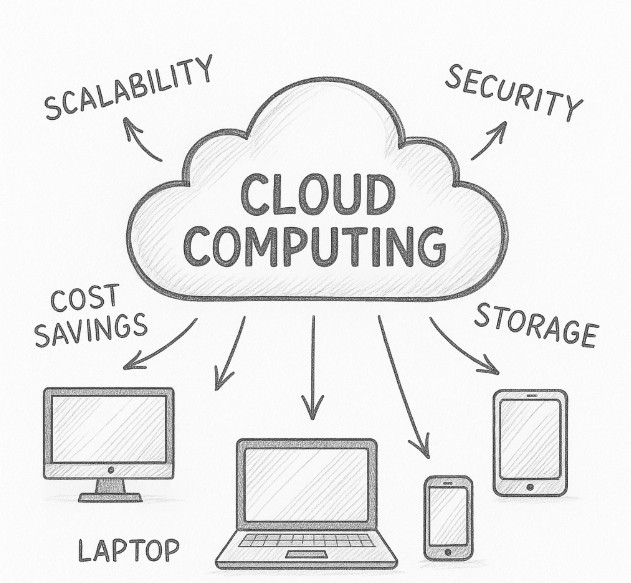We live in an era where agility, security, and scalability are the pillars of competitiveness. Companies that don’t adopt the cloud quickly fall behind those that do.
Implementing Cloud Computing allows you to:
Optimize costs: there’s no longer a need to purchase expensive servers or pay for constant maintenance.
Instant scaling: you can increase or decrease resources based on market demand.
Facilitate continuous innovation: access to advanced services (AI, Big Data, Machine Learning, Blockchain, etc.) is just a click away.
Increase security: leading providers offer data encryption, automatic backups, and compliance with international regulations.
Promote collaboration: employees from different countries can work in the same environment, in real time.
⚙️ Types of Cloud Computing
IaaS (Infrastructure as a Service): infrastructure as a service. Examples: Amazon Web Services (AWS), Microsoft Azure, Google Cloud Platform.
PaaS (Platform as a Service): A platform for developing applications without worrying about infrastructure. Examples: Heroku, Firebase, Red Hat OpenShift.
SaaS (Software as a Service): Ready-to-use software in the cloud. Examples: Salesforce, Dropbox, Slack, Google Workspace.
💼 Real-life success stories
🟩 Netflix
Netflix migrated almost its entire infrastructure to Amazon Web Services (AWS). The result:
Cost reduction of more than 40%.
Massive scalability (millions of concurrent users).
High availability: No interruptions during global traffic spikes.
🟦 Airbnb
The platform uses the cloud to process user requests in real time, manage payments, send notifications, and maintain a smooth experience.
Thanks to the cloud, it can operate in more than 190 countries without having its own data centers.
🟥 Spotify
Spotify stores and analyses data from more than 500 million users using Google Cloud.
This allows it to offer personalized playlists with AI and analyse musical trends in seconds.
🟨 Unilever
The multinational migrated to the cloud with Microsoft Azure to centralize data from all its subsidiaries.
The result: a 30% reduction in market analysis time and faster decisions based on real data.
💡 Advantages of Cloud Computing
Advantage Description
Cost Reduction: You pay only for the resources you use; without large upfront investments.
Scalability and Flexibility: Adjust capacity in minutes, based on demand.
Global Accessibility: Access from any location and device with an internet connection.
Advanced Security: Encryption, multi-factor authentication, firewalls, and continuous monitoring.
Integration with AI and Big Data: Modern clouds integrate advanced analytics, machine learning, and automation.
Backup and Recovery: Automatic backups and data recovery after failures or attacks.
⚠️ Disadvantages or Challenges
Disadvantage Description
Internet Dependence: If the connection fails, access to services is temporarily lost.
Variable Costs: If not managed properly, costs can increase with intensive use.
Sensitive Data Security: Although providers are secure, internal misuse can compromise information.
Complex Initial Migration: Some companies require professional advice for the transition.
Vendor Lock-In: Changing cloud providers can be complicated (vendor lock-in).
🧠 Most Used Tools
Amazon Web Services (AWS) – global leader, ideal for large and scalable projects.
Google Cloud Platform (GCP) – excellent for AI, machine learning, and data analytics.
Microsoft Azure – seamless integration with enterprise environments (Office, Windows Server, etc.).
IBM Cloud and Oracle Cloud – geared toward the financial and corporate sectors.
📊 Data and Trends
According to Gartner (2025), 95% of new business workloads will run in the cloud.
Companies that migrate to the cloud increase their productivity by up to 40%.
It is estimated that the adoption of cloud services will grow by 21% annually over the next five years.
Implementing Cloud Computing in a business is not just a technological decision:
it is a strategic decision for the future.
It means leaving behind the rigidity of the past to embrace continuous innovation, operational efficiency, and the freedom to grow without physical limits.
